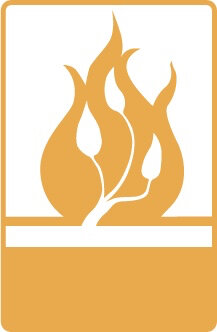Healing the Heart: Exploring Heart Rate Variability and Trauma
At the top of the heart, a small bundle of cells known as the sinoatrial node regularly send out an electrical impulse. The signal causes the walls of the heart to contract, sending blood into the ventricles and then out to circulate through the body. For some of us the rhythm of the heart is quite irregular and that arrhythmia can be dangerous. But small variations in heart rhythm are actually very healthy.
Imagine someone who’s heart beats at 60 beats a minute, or once a second. That rate is actually not exactly one beat per second but may deviate by a few milliseconds quicker or slower each time. That variability is actually quite healthy and very important to our physical and emotional health. Those who have more “heart rate variability” are more resilient and adaptable to stress. In essence they are more fluid and flexible and stressors don’t bother them quite as much. Those who have less variability and a more regular rhythm have less resiliency and can become more easily aroused and stressed out.
In a way its counter-intuitive. Usually we equate a steady heartbeat with a more steady disposition but in fact it is just the opposite. That steady regular beat associated with heightened stress is actually a sign of increased rigidity and inflexibility. A more chaotic beat is a sign of more fluidity and dynamism. We know from studying ecology that the natural world can be modeled by spiral patterns of complex fractals. Variable complex ecosystems such as old growth forests will be far more resilient than tree farms with single trees planted in rows.
Variability and chaos are key to good health.
Trauma and Heart Rate Variability
Significant trauma causes heart rate variability to decrease. The heart becomes more rigid as a way of coping with stress. Think of this as similar to how one freezes when presented with a threat. The body moves towards more rigidity, more inflexibility, more tightness.
Never Morning Wore to Evening but Some Heart Did Break by Walter Langley
The heart has two main nerves associated with it. The accelerans nerve is associated with the sympathetic nervous system and speeds up the heart and makes it more regular when there is danger. The vagus nerve is associated with the parasympathetic nerve and helps the heart to calm, slow down and become more irregular and variable. The vagus nerve emits from the brainstem and links to the face, the eyes, down to the heart, lungs gut, kidneys and reproductive organs. When the vagus nerve is operating well, then the body easily rests at a more relaxed parasympathetic state. This is known as good vagal tone.
Now imagine a small child crying out to a parent because they are hungry, cold, tired or lonely. When a parent comes into the room and soothes the child with eye contact, gentle cooing sounds and warm skin to skin contact, the vagus nerve with its sensors in the eyes and face is stimulated. It then signals for the release of acetylcholine in the heart which helps calm it and bring greater variability. But now imagine if you did not receive that same level of comfort. Perhaps parents were angry, neglectful and abusive. Or perhaps parents are under stress due to poverty and oppression and have a challenging time offering optimal care because of systemic injustice. There is no way to calm down the stress response and the nervous system stays in heightened arousal. The heart receives the signal to stay on alert with a fast heart beat and decreased variability.
We know from research that when a child experiences trauma, heart rate variability is decreased and that can have lasting effects into adulthood. Essentially, heart rate can become rigid and excessively steady leading to much greater susceptibility to stress as an adult. The heart is conditioned to poorly respond to stress and become more highly reactive to the environment.
Heart Work: The Wounds of Modernity
The modern world is designed to challenge the rhythm and flow of our hearts. Most of us no longer spend long hours outdoors breathing in the aromatic compounds from the trees and hills that help our hearts to remain strong and calm. We are distant from the normal rhythm of day and night, sleep and wake cycles attuned to the variations of the seasons and the movements of the sun. Most of us are attuned to the rhythm of clocks and alarms, work schedules and deadlines. As we moved away from the agrarian age to the industrial age, we shifted to the rhythms of factories and shift work. Season and time of day no longer mattered. In the age of computers, we entrain ourselves to the speed and rhythm of news, social media updates, emails and videos from morning to well past dusk.
There is a collective trauma happening as we increasingly distance ourselves from field and forest, as we become increasingly entrained in technological and shift work rhythms. The pace has quickened. Stressors are almost constant. Those who are under constant threat and prejudice such as people of color, those in poverty and the LGBTQ communities can have a much harder time improving heart rate variability due to systemic injustice. The frenetic pace of modernity along with systemic injustice are truly a wound to the collective heart, calling for healing at a societal level.
Healing the Heart: Tools for Greater Vagal Tone
Decreased heart rate variability is akin to a wounded heart that needs slow and steady repair to heal. Traditional healing systems have a multitude of techniques for stimulating the vagus nerve, improving heart rate variability and strengthening emotional resiliency.For those with limited means, accessibility is a key issue here. The good news is that many of the tools for improving HRV are cheap or free.
Rest: One of the most important lessons in athletically training is to make sure there is adequate time between workouts for proper rest and recovery. This allows the body to repair tissue and muscle damage and helps increase long term stamina and endurance. In physical training, workouts actually lower HRV. Working out is a form of stress and its key to have a period of rest afterwards to allow HRV to rise. With folks who have had trauma, their heart rate variability is stuck at a low level, so there is need for a lot of counterbalancing rest. This can really mean months and sometimes years of taking more time to be quiet, turn off the screens, bathe and take long naps and get plenty of sleep at night.
Sacred movement: Exercise that helps improve flexibility and relaxation can be deeply helpful for improving heart rate variability Qi gong and yoga are systems of sacred movement that encourage greater resiliency, strength and improve HRV. It is important to note that some forms of yoga are often too strenuous and intense for people recovering from trauma and gentle forms of vinyasa and yin yoga are more helpful for improving HRV.
Breath techniques: Some of the best ways to improve heart rate variability is to engage in deep breathing exercises. This doesn’t have to be complicated and literally focusing on slowing down one’s inhalations and exhalations can have a profound effect on improving heart rate variability.
With my clients I suggest a simple exercise of breathing in for 4 counts and exhaling for 6 counts. That comes out to 6 breaths a minute and it only takes a couple minutes of doing this to notice a good effect. Another technique is to breathe in for 4 counts, hold for 4 counts and then exhale for 8 counts.
Finally, a powerful technique that traditionally has been used to strengthen the nervous system and reduce anxiety is called alternate nostril breathing. In this technique, try holding your right thumb to your right nostril and breathe in deeply for 4 counts. Then hold both your thumb and third finger on your nostrils and hold your breath for 4 counts. Then release your right thumb and exhale through your right nostril for 8 counts. At the end of the exhale, inhale through the same right nostril for four counts. Hold both thumb and third finger to your nostrils. Then release your third finger and exhale through your left nostril. Repeat this cycle for 5 minutes.
Forest Bathing: One of the most powerful ways to help improve heart rate variability is to engage in Forest Bathing. For about 8 years, Japanese researchers examined the effects of spending time in forests resting andtaking in the natural air. One of the findings is that heart rate variability improved. One of the main reasons they cited was due to the aromatic compounds emitted from trees that have a calming and healing quality. So taking walks in nearby forests has a profound effect on healing the heart through improving vagal tone.
Aromatherapy: Research is increasingly pointing to aromatherapy as a key tool for helping improve heart rate variability. For many people who are stuck in severe trauma symptoms patterns such as dissociation, freezing, derealization and panic, aromatherapy can be one of the most profound tools available. Instead of having to focus on doing something such as taking a walk, doing breathing exercises or yoga, the simple act of taking in the scent of essential oils can induce a parasympathetic response that helps calm the heart and improve vagal tone. This can happen in a variety of ways-
Smudge: Smudging with sustainably harvested cedar, sage or mugwort are time honored ways of releasing volatile oils that improve mood.
Infused herbal oils: Try massaging your skin with oils that have been infused with herbs such as lavender, rosemary, lemon balm and rose.
Small batch distilled oils: Try working with essential oils that have been lovingly crafted in a sustainable way. You can add them to bath salts, massage oils, to diffusers and sprays for helping to strengthen vagal tone.
Mountain Rose Herbs has a great section on aromatherapy with organic ingredients here.
Conclusion
Trauma work is heart work. Abuse and neglect can cause long term wounds to the very rhythm, speed and pulse of our heart. When the heart beats at a rate that is too steady, rigid and unbending, the work is to loosen that process up- to bring more flexibility and dynamism to that flow. The process of shifting from a sympathetic dominant state to a more parasympathetic state can be aided by traditional techniques such as breath, sacred movement, aromatic herbs and connecting to nature to heal the rhythm of the heart. Go well on your journey.
Some additional reading:
What is Heart Rate Variability? And Why does it Matter?
Heart Rate Variability is Associated with Emotion Recognition
32 Ways to Stimulate your Vagus Nerve
Vagal Tone and the physiological Regulation of Emotion
Measure your resilience with Heart Rate Variability using your smartphone
Track your HRV to boost adaptive reserves
The effects of patterned breathing and continuous positive airway pressure on cardiovascular regulation in healthy volunteers.
The Effect of Lavender Aromatherapy on Autonomic Nervous System in Midlife Women with Insomnia
Aromatherapy Benefits Autonomic Nervous System Regulation for Elementary School Faculty in Taiwan
Heart rate variability index in trauma patients.
Heart rate variability (HRV) and posttraumatic stress disorder (PTSD): a pilot study.
This article written by Jon Keyes, Licensed Professional Counselor and herbalist. For more articles like this, please go to www.Hearthsidehealing.com.
You can also find me at the Facebook group Herbs for Mental Health.










